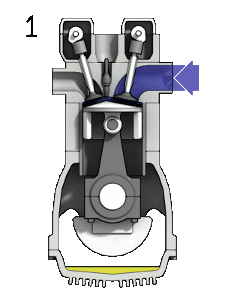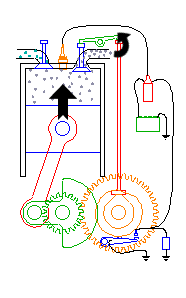Thursday, December 23, 2010
BAGAIMANA ENJIN BERFUNGSI
Four Stroke Engine
The four stroke engine was first demonstrated by Nikolaus Otto in 18761, hence it is also known as the Otto cycle. The technically correct term is actually four stroke cycle. The four stroke engine is probably the most common engine type nowadays. It powers almost all cars and trucks.
Speed 10 fps
The four strokes of the cycle are intake, compression, power, and exhaust. Each corresponds to one full stroke of the piston; therefore, the complete cycle requires two revolutions of the crankshaft to complete.
Intake
During the intake stroke, the piston moves downward, drawing a fresh charge of vaporized fuel/air mixture. The illustrated engine features a poppet intake valve which is drawn open by the vacuum produced by the intake stroke. Some early engines worked this way; however, most modern engines incorporate an extra cam/lifter arrangement as seen on the exhaust valve. The exhaust valve is held shut by a spring (not illustrated here).
Compression
As the piston rises, the poppet valve is forced shut by the increased cylinder pressure. Flywheel momentum drives the piston upward, compressing the fuel/air mixture.
Power
At the top of the compression stroke, the spark plug fires, igniting the compressed fuel. As the fuel burns it expands, driving the piston downward.
Exhaust
At the bottom of the power stroke, the exhaust valve is opened by the cam/lifter mechanism. The upward stroke of the piston drives the exhausted fuel out of the cylinder.
Ignition System
This animation also illustrates a simple ignition system using breaker points, coil, condenser, and battery.
A number of visitors have written to point out a problem with the breaker points in my illustration. In this style ignition circuit, the spark plug will fire just as the breaker points open. The illustration appears to have this backwards.
In fact, the illustration is correct; it just moves so fast it's difficult to see! Here's a close-up of the frames just at the point the plug fires:
breaker point closeup
My original intent was to accurately show that the points need to remain closed for only a fraction of a second, called the dwell. By illustrating this, I inadvertently obscured the overall operation of the circuit. Perhaps someday I'll prepare a more detailed illustration of the ignition system alone.
Larger four stroke engines usually include more than one cylinder, have various arrangements for the camshaft (dual, overhead, etc.), sometimes feature fuel injection, turbochargers, multiple valves, etc. None of these enhancements changes the basic operation of the engine
WANKEL ENGINE (DI KENALI SBG ROTARY ENGINE - MCM ENJIN KETA MAZDA RX-7)
The Wankel rotary engine is a fascinating beast that features a very clever rearrangement of the four elements of the Otto cycle. It was developed by Felix Wankel in the 1950s.1
In the Wankel, a triangular rotor incorporating a central ring gear is driven around a fixed pinion within an oblong chamber.
Intake
The fuel/air mixture is drawn in the intake port during this phase of the rotation.
Compression
The mixture is compressed here.
Power
The mixture burns here, driving the rotor around.
Exhaust
And the exhaust is expelled here.
The rotary motion is transferred to the drive shaft by an eccentric wheel (illustrated in blue) that rides in a matching bearing in the rotor. The drive shaft rotates once during every power stroke instead of twice as in the Otto cycle.
The Wankel promised higher power output with fewer moving parts than the Otto cycle engine; however, technical difficulties interfered with widespread adoption. In spite of valiant efforts by Mazda, the four stroke engine remains much more popular.
SUMBER : http://www.animatedengines.com/otto.shtml
2011 TAKAYANAGI MILUIRA + 2011 SUBARU FORESTER»
-2011 TAKAYANAGI MILUIRA
The little open-top Takayanagi Miluira with retro style from Japan featuring a design that resembles cars from the early 1900s, it measures just 2.18 meters (85.8 inches) in length and can only accommodate the driver.
It is electric car like the Nissan Leaf and Chevrolet Volt. According to the [...]
TEKNOLOGI
TEKNOLOGI ASAS TELAH BERMULA APABILA MANUSIA ZAMAN PURBA MEMBUAT PERALATAN SENJATA RINGKAS DARIPADA KAYU ATAU BATU UNTUK MENGERAT,MENIKAM,MEMAHAT ATAU MEGGERGAJI BAHAN KAYU,SEHINGGA PEMBINAAN PENCAKAR LAUT SEPERTI MENARA BERKEMBAR PETRONAS, IAITU ANTARA BANGUNAN TERTINGGI DI DUNIA PADA MASA INI.TEKNOLOGI JUGA TERMASUK ALAT PERTANIAN,PERUBATAN,TENAGA,PENGANGKUTAN,KOMUNIKASI DAN AKTIVITI MASA LAPANG.
TEKNOLOGI ialah satu usaha manusia menggunakan akal dan sagala ilmu sains untuk menghasilkan peralatan dan kelengkapan untuk memenuhi keperluan diri, ahli keluarga dan masyarakatnya.
Sains ialah ilmu pengatahuan tentang alam sekitar dan teknologi ialah usaha berikhtiar menggunakan ilmu sains ini untuk memperoleh manfaat untuk keperluan semua manusia.Islam tetap mengutamakan kedua-duanya menuntut ilmu sains dan mengusahakan teknologi.
Manusia purba yang hidup di dalam gua telah memburu haiwan dan memungut bahan makanan dari hutan dan meperolehi pelbagai bidang ilmu pengatahuan daripada pengalaman sendiri.Selagi mereka berpindah-pindah dari tempat ke setempat,tidak banyak teknologi dihasilkan.
Apabila mereka tinggal di tempat yang tetap mereka memulakn aktiviti pertania dan penternakan.Mereka juga telah menghidup dan menggunakan api,membuat alat primitif untuk menebang pohon,menggali lubang di dalam tanah mengusahakan teknologi untuk menanam tumbuhan,mengerat bahan makanan,memahat dan menebuk batang pokok untuk membuat perahu dan mebuat senjata tajam untuk memburu atau meyelamatkan keluaraga daripada musuh.mereka juga membina rumahsendiri dan meggemburkan tanah sertamengairkannya,menyemai benih tanaman,menuai bijiran,sayuran atau buahan dan memperoses makanan dan menyimpan bijiran untuk kegunaan masa hadapan .Ini permulaan teknologi.
Di petik dari :Ensiklopedia sains dan Al-Quran - Jilid 10
Subscribe to:
Comments (Atom)











